Kanchanaburi Province is arguably hard to beat in terms of accessibility, activities, natural beauty, and history. It is about 128 km from the capital, Bangkok, and is a must-see destination for any family trip to Thailand, for those who want to discover temples, waterfalls, majestic rivers, cavernous caves, and immaculate national parks.
General Information
Located at the confluence of the Kwai Yai and Kwai Noi rivers, Kanchanaburi is close to the Mae Klong River, which helps define the charming features of the land. Many travelers head to Kanchanaburi for a one or two-day trip, but the wide range of attractions on offer makes it possible to stay a week or more. Besides the lush forests and spectacular waterfalls, there are also popular activities like golf, elephant trekking, white water rafting, and three large reservoirs to explore. This is a destination in Thailand that is sure to appeal to tourists who are interested in nature.
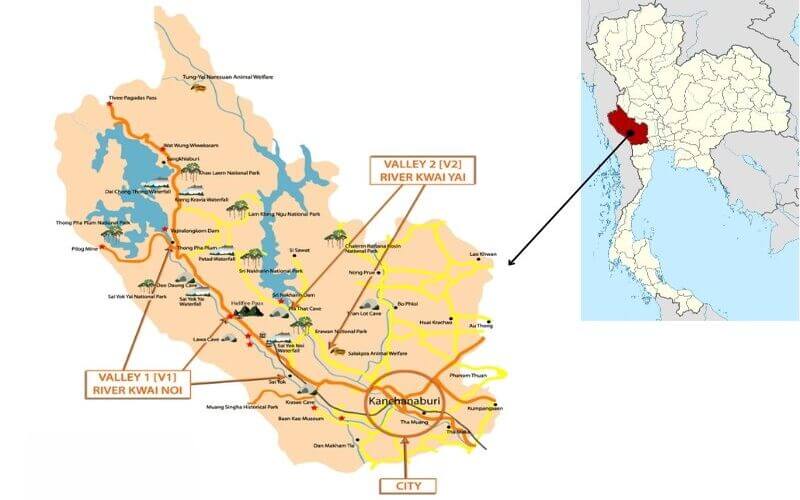
Kanchanaburi Map
Weather & Best Time To Visit Kanchanaburi
Kanchanaburi is located in central Thailand and has a tropical monsoon climate. The rainy season runs from May to October, with heavy rainfall and high, humid temperatures. The best time to visit Kanchanaburi is from November to February when temperatures are cooler and rain less. The average temperature is between 20 °C and 30 °C during this time, making it a pleasant time to explore local attractions like the River Kwai Bridge and surrounding national parks. If you visit Kanchanaburi during the rainy season, make sure to bring a raincoat or an umbrella as the rains can be heavy and sudden.
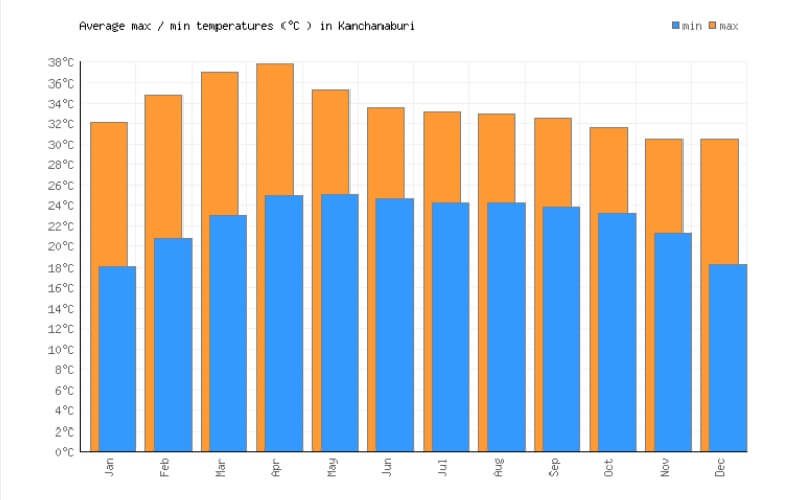
Average Temperature in Kanchanaburi
Getting to Kanchanaburi
The ideal means of transport to get to Kanchanaburi is by bus, which runs regularly from Bangkok’s South Bus Terminal. Buses run daily from 4 a.m. to 8 p.m. and the travel time is approximately 3 hours. There is also a first-class air-conditioned bus service that departs from the same terminal but at less frequent departure times.
Other bus lines depart from Nakhon Pathom, which would normally take you around 90 minutes on the bus, while the service from Suphan Buri and Ratchaburi can take up to 3 hours.
A train departs twice a day from Thonburi station in Bangkok and takes around 3 hours to reach Kanchanaburi. But the train is more expensive for tourists, around $3 (compared to around $0.50 for locals).
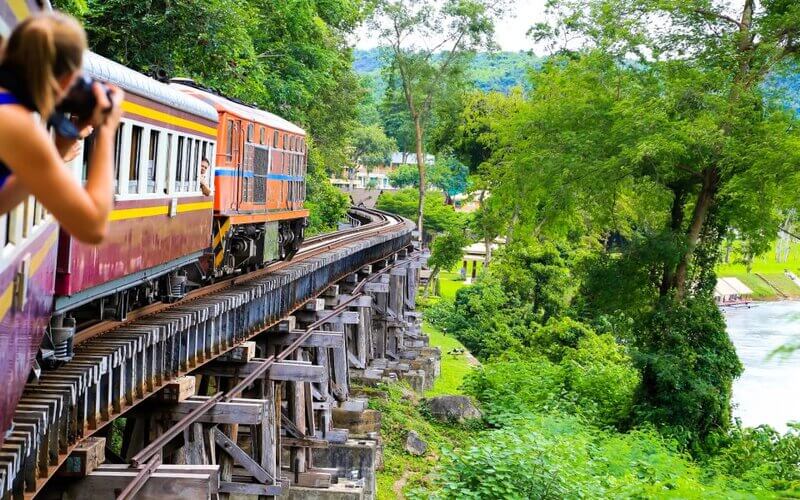
Train From Bangkok To Kanchanaburi
Another travel option is to rent a private car with a driver in Thailand, which is faster and more convenient than regular buses. You can rest assured because the price and quality of the car are fixed before departure.
Getting around Kanchanaburi
The most common means of transport upon arrival in Kanchanaburi is by motorbike taxi, although there are a few rickshaws and Bangkok-style tuk-tuks in the area. Most local rides cost between $2 and $3. Another popular service is travel by songthaews which loops around town and cost less than $1.
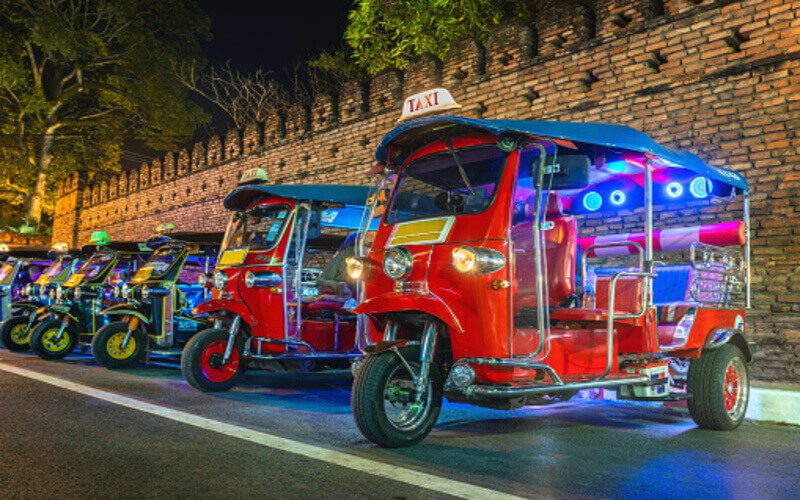
Tuk tuk
One of the most convenient options is to rent a bike for the day from a local guest house. There are plenty of rental outlets so it shouldn’t be hard to find a bicycle for around $1-1.50 a day. Most city attractions are within 5 km of the river, making it easy to explore. Motorbikes are also available for rent and cost around $5-8 daily.
Accommodations in Kanchanaburi
Kanchanaburi offers many forms of accommodation including premier hotels and resorts that offer the best amenities, services, and hospitality. If you want to extend your stay and explore the area more, you might consider staying at well-known establishments such as:
- X2 River Kwai Resort 5*
- Dheva Mantra Resort & Spa 5*
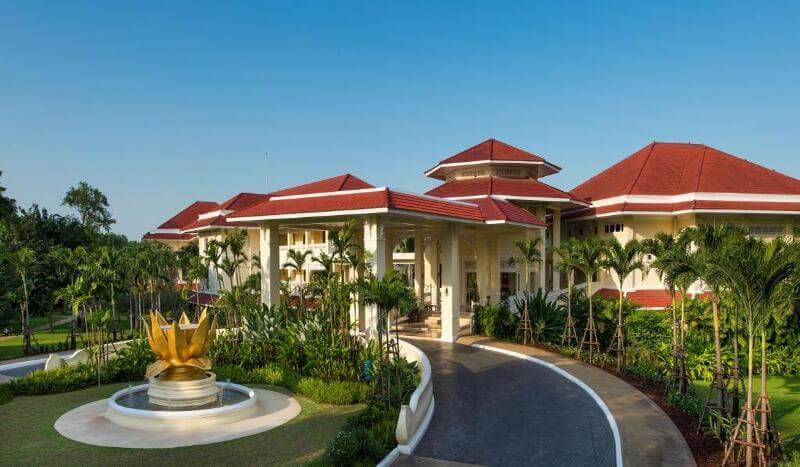
Dheva Mantra Resort
- Boutique Raft Resort 4*
- Royal River Kwai Resort & Spa 3*
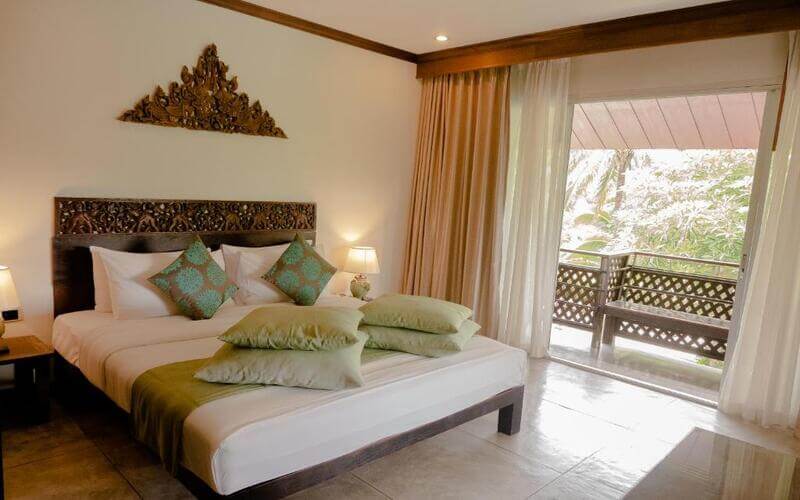
Royal River Kwai Resort & Spa
- Good Times Resort 3*
These accommodation options provide an exceptional stay experience for travelers seeking luxury and comfort while staying in Kanchanaburi.
Best Places To Visit in Kanchanaburi
Kwai Point River
Kanchanaburi has the famous Kwai Bridge River. It was built during World War II by American, Dutch, and British war prisoners. This bridge is also known as the ‘Death Railway’, due to the number of men who died building it. The project was overseen by Japanese forces who wanted the railway to help supply troops in neighboring Burma. Today, it is possible to walk across the bridge, with some areas still able to keep their original structures.
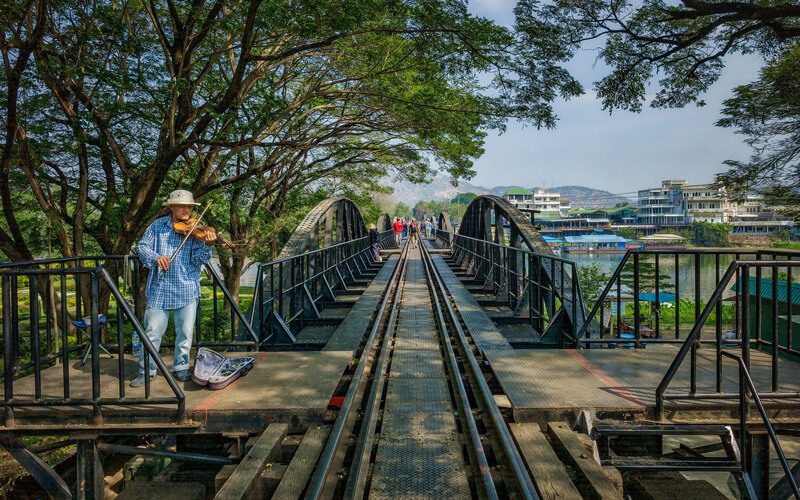
Kwai Point River
Hellfire Pass and Memorial Museum
Hellfire Pass is a stretch of the Thailand-Burma Railway, about 80 km Northwest of Kanchanaburi. The entire railway line has a gruesome past, with thousands of local workers and Allied war prisoners killed during its construction during World War II. The name of this particularly deadly section comes from paintings depicting laborers working by firelight at night and from witnesses saying it looked like hell. Today, it is possible to take the old railway line into the jungle (which takes around 4–5 hours) and visit a memorial museum honoring those who died.
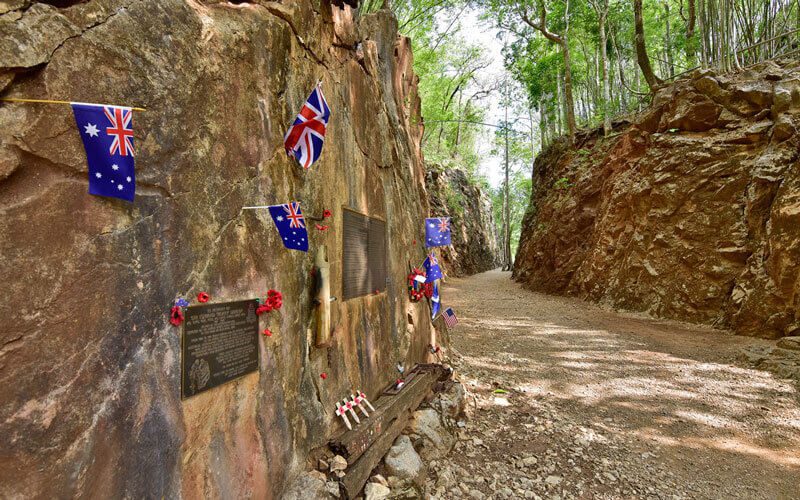
Hellfire Pass
Created by the Australian Government to honor the Allied prisoners of war, the museum tells the harrowing story of these men through artifacts, tools, photos, and multimedia displays. Headphones are strongly recommended.
JEATH War Museum
This sobering museum was designed as an exact replica of a real war prisoner’s camp. Located within the grounds of Wat Chai Chumphon, the museum is maintained by a monk and allows travelers to experience the harsh realities of life in these camps.
The replica includes bunks, photographs, other authentic items, and accounts written by actual former prisoners, their family members, and authors who interviewed the war prisoners. The name of the museum comes from the countries which took part in these events, Japan, England, Australia/United States, Thailand, and Holland (Netherlands).
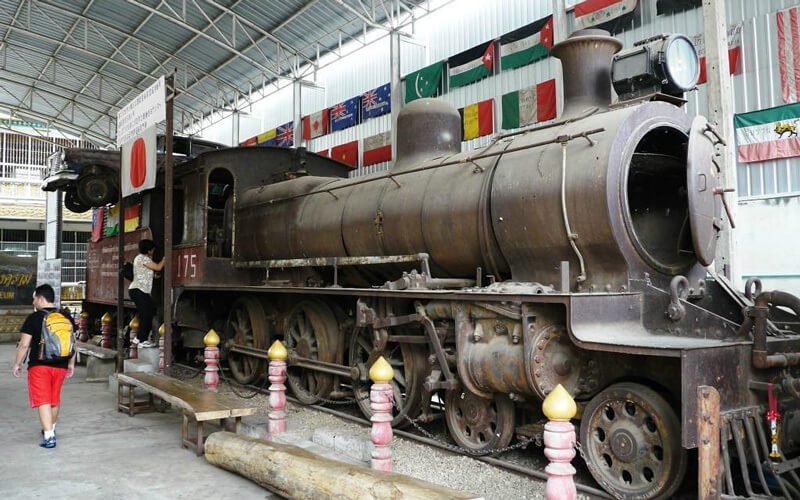
JEATH War Museum
Kanchanaburi War Cemetery
Kanchanaburi Military Cemetery is in the center of Kanchanaburi. With its 6,982 graves, it is one of the largest military cemeteries in Thailand. The site provides a peaceful resting place for war prisoners, mainly British, Australian, and Dutch, who were sent to work on the railway between Thailand and Burma. A second cemetery, Chong Kai War Cemetery, lies about 4 km to the South and contains another 1,740 graves.
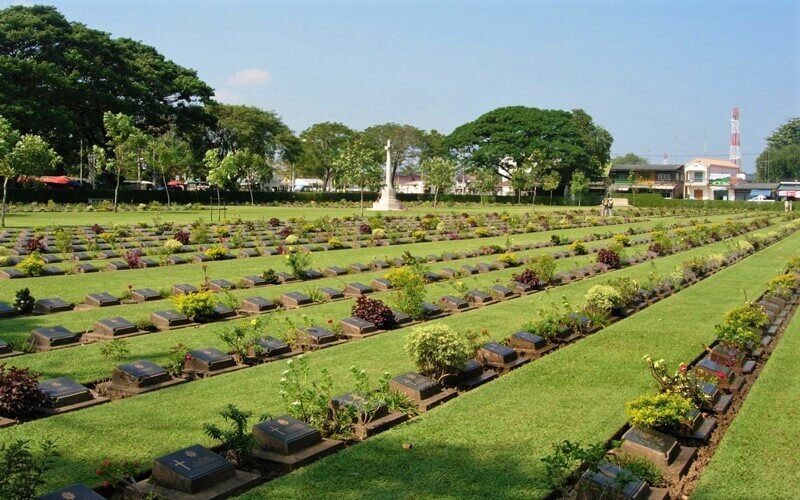
Kanchanaburi War Cemetery
One cannot help but feel the importance of the place while walking around the tombs. There are even a few dozen unidentified graves. Walking past the graves and reading the inscriptions can be a moving experience, especially when you realize how young some of the prisoners were. Worse, these graves represent only a small number of the prisoners who died working in incredibly harsh conditions to build the railway.
Thailand–Burma Railway Center
The well-designed exhibits at the Thailand-Burma Railway Center provide an excellent insight into the history of the railway and the brutal conditions endured by the prisoners and forced laborers who built it. Personal stories, photographs, artifacts, and videos shed light on this dark slice of history, from the Japanese invasion to the lives of some survivors after the war.
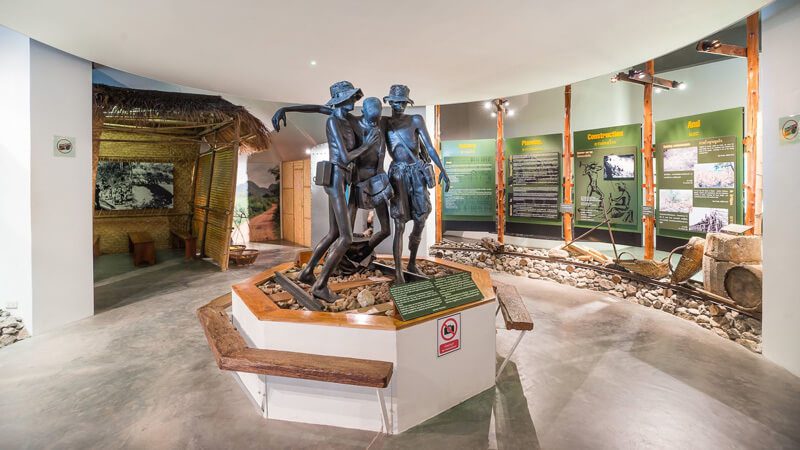
Thailand–Burma Railway Center
Kanchanaburi Temples and Shrines
It is worth visiting the temples and shrines of Kanchanaburi, which have taken advantage of the amazing geography of the region. Some rise above sea level, offering unparalleled views of the surrounding plains, while others are built in underground caves.
- Wat Tham Sua (Tiger Temple) owes its name to the giant felines that lived in the caves. Stairs provide access to the top, where an 18-meter-tall golden Buddha watches over you.
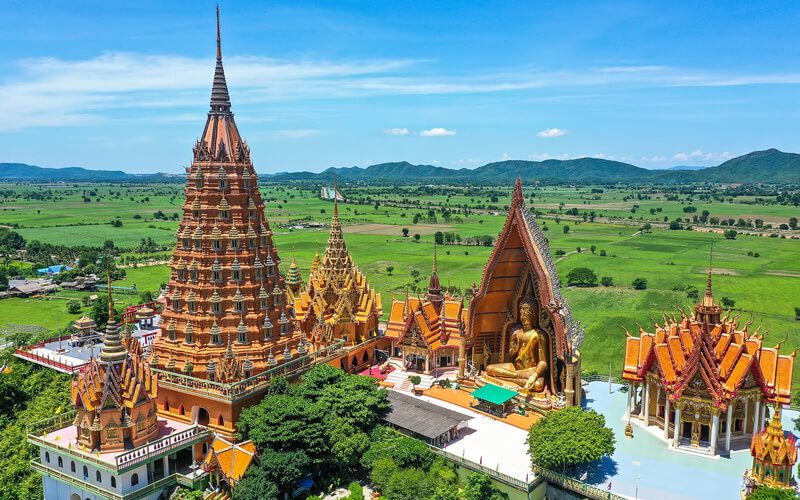
Wat Tham Sua
- Wat Ban Tham (Dragon’s Head Cave) is accessible by 900 steps, and you can enjoy breathtaking views as your reward once you reach the top.
- You can then descend to Tham Phu Wat (temple in a cave) to discover the underground complex.
Erawan National Park
Erawan National Park provides a soothing counterpoint to some of Kanchanaburi’s emotionally historical attractions, and the scenic seven-tiered Erawan Falls are the main attraction. The water flows into the mountains in a serene setting, surrounded by lush vegetation and limestone mountains.
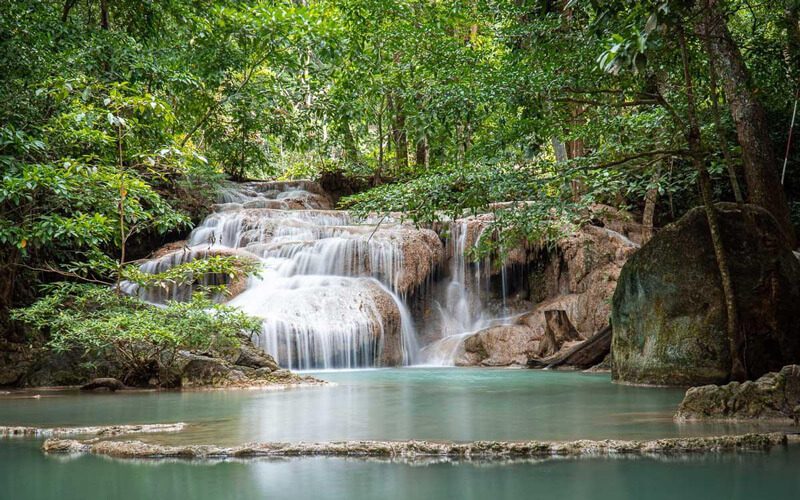
Erawan Falls
A scenic hiking trail leads to the top of the falls (watch out for thieving monkeys on the way), and the turquoise pools are a lovely place to take a refreshing dip on a hot day. Dip your feet in the water and you might feel fish nibbling at your toes.
Elephant World Kanchanaburi Reserve
Most people come to Thailand hoping to have an amazing experience with an elephant, the country’s most popular creature. Elephant’s World offers visitors the opportunity to do so ethically. The elephants are survivors who have suffered from years of work and abuse.
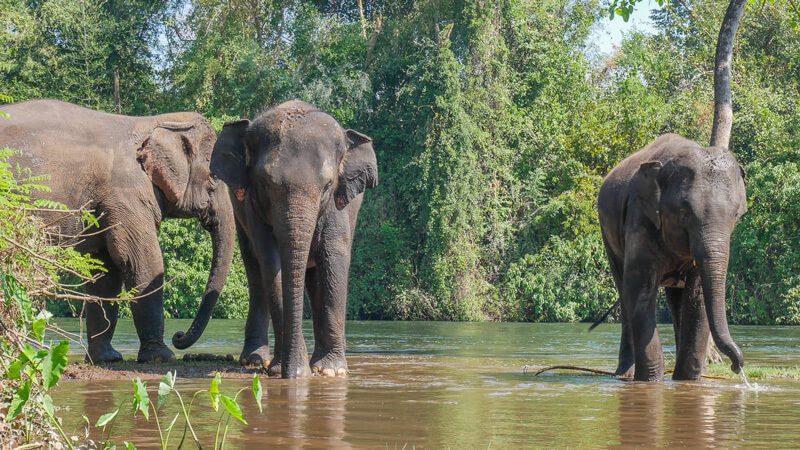
Kanchanaburi Elephant World Reserve
Rather than riding elephants or watching them perform, you spend the day serving the animals – preparing food for them and bathing them in the river. It’s a way to care for abused elephants and to volunteer in a meaningful way.
Khuean Srinagarindra National Park
Surrounded by lush hills, the Srinagarind Dam along the Khwae Yai River is the centerpiece of the peaceful Khuean Srinagarindra National Park. This park is less crowded than the nearby Erawan National Park and is home to impressive cave systems with stalagmites and stalactites, as well as a variety of wildlife including civets, bats, leopards, and slow lorises.
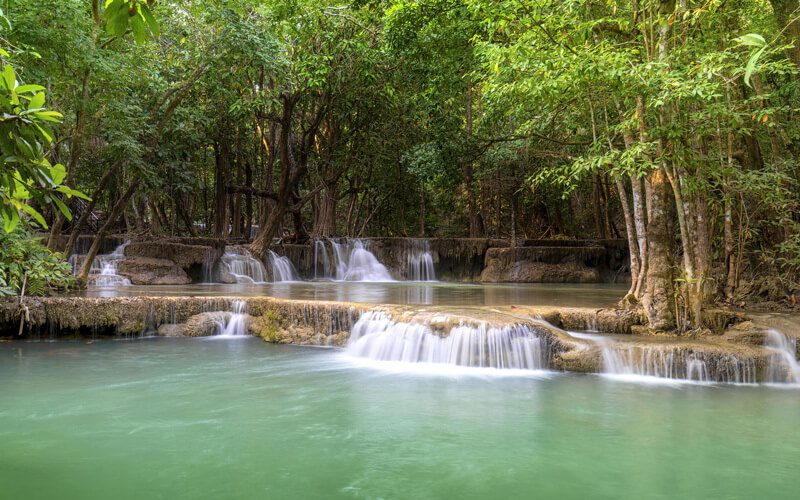
Khuean Srinagarindra National Park
Do not miss visiting the beautiful waterfalls of Huay Mae Khamin, which you can reach by boat or 4×4. The small park near the viewpoint over the dam is a great place for a picnic.
Prasat Muang Singh National Park
This popular archaeological site, located not far from the city center, includes four 13th-century Khmer-style ruins and an ancient human burial site.
The main ruin is an ancient temple built of laterite stones on a rectangular base, with a corn-shaped prang at its epicenter. The temple is surrounded by four cloister walls and four entrance doors with lintels carved in stone. Archaeological evidence suggests a strong Khmer influence in the area and that the temple was built as a place of worship for Mahayana Buddhists.
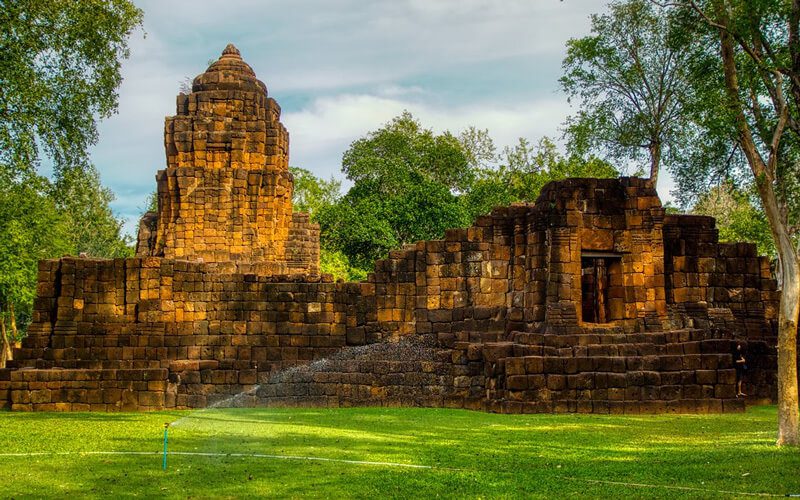
Prasat Muang Singh National Park
Kanchanaburi Night Market
The Kanchanaburi JJ Night Market opens every day around 6 pm and offers a wide range of local dishes at affordable prices. Located close to Kanchanaburi Station, this is a large market that caters mainly to locals and tourists looking to sample authentic Thai food.
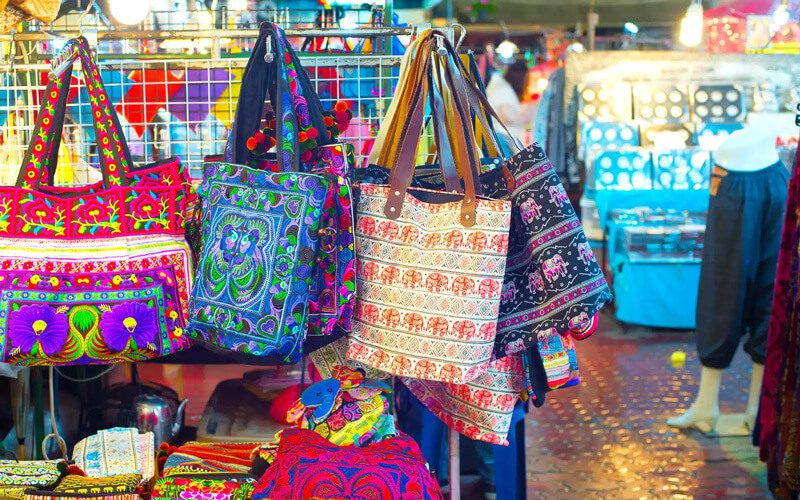
Kanchanaburi Night Market
Dozens of food stalls sell noodles, meat skewers, fruit smoothies, and, of course, plenty of papaya salads. After eating, you can relax and admire the view of the Kwai Yai River.
Must-Eat Foods And Best Restaurants in Kanchanaburi
This small town is not only known for its horrific wartime past, but it’s also a great place to immerse yourself in traditional Thai culture, including food. From quaint rural restaurants to stylish riverside establishments to bustling local markets, here are the best places to eat in Kanchanaburi.
Zab Zab
Zab Zab is a top address to sample the best food in Kanchanaburi at a reasonable price. This no-frills restaurant serves a great selection of delicious regional dishes, making it a popular option for locals and discerning travelers alike. Papaya salad, spring rolls, and fried chicken wings are among the most popular dishes.
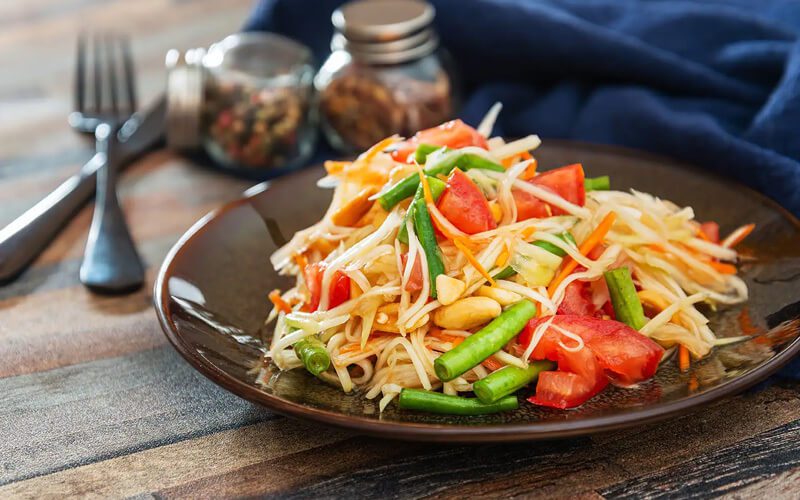
Papaya Salad – Zab Zab
Address: Ban Tai, Kanchanaburi, Thailand
Floating Raft Restaurant
The Floating Raft Restaurant is aptly named, it’s a restaurant in Kanchanaburi that floats on a raft. The thatched-roof floating craft sways in the calm waters of the River Kwai, giving every diner a breathtaking view of the waterfront. At lunchtime, the self-service buffet offers an array of dishes traditional Thai dishes, most of which consist of fish caught in the river on the same day. Dishes like fried noodles, sea crab, and papaya salad satiate dinner patrons.
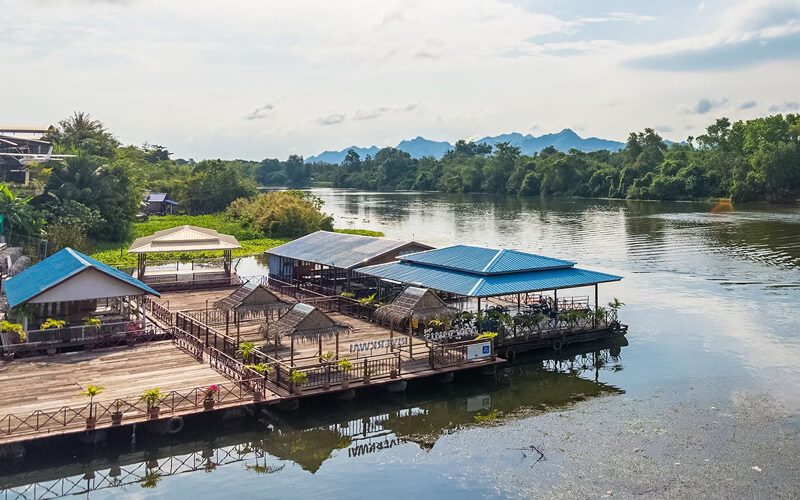
Floating Raft Restaurant
Address: 425 River Kwai, Tha Ma Kham, Mueang Kanchanaburi, Kanchanaburi
Kan Buri
The cheap and cheerful Kan Buri restaurant serves exquisite dishes. Although sautéed pork is the star, you’ll find a wide choice of other traditional dishes on the menu. And for those who are homesick, the pizzas and calzones are very good. The fast and smiling service enhances your experiences even more.
Address: 339/1 River Kwai, Tambon Thamakham, Mueang Kanchanaburi, Kanchanaburi
Kanchanaburi Night Market
As stated above, the night market is the obvious option if you want an authentic yet inexpensive Thai feast in Kanchanaburi. Some come to buy cheap clothes or imported Chinese electronics, but most are there to enjoy freshly prepared food.
The market is filled with an impressive number of street vendors selling all kinds of traditional Thai dishes. From green curries and grilled meats to a decadent selection of sweets, there’s a takeaway for everyone. Want something new? Try the tapioca balls stuffed with pork and peanuts.
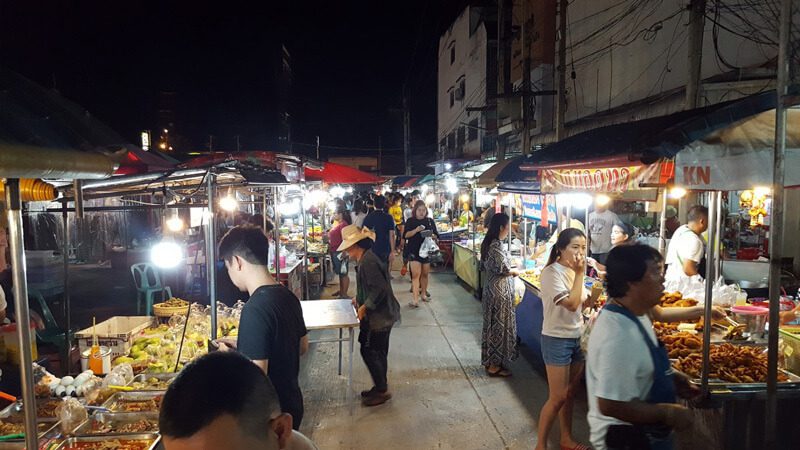
Kanchanaburi Night Market Food Stalls
The city of Kanchanaburi is a microcosm of what makes Thailand such a fascinating country. Here you will find a mix of historic sightseeing and lush tropical areas, where you can appreciate the unique natural beauty of the Land of Smiles. Do not hesitate to contact us now for a tailor-made trip to Thailand and Kanchanaburi.